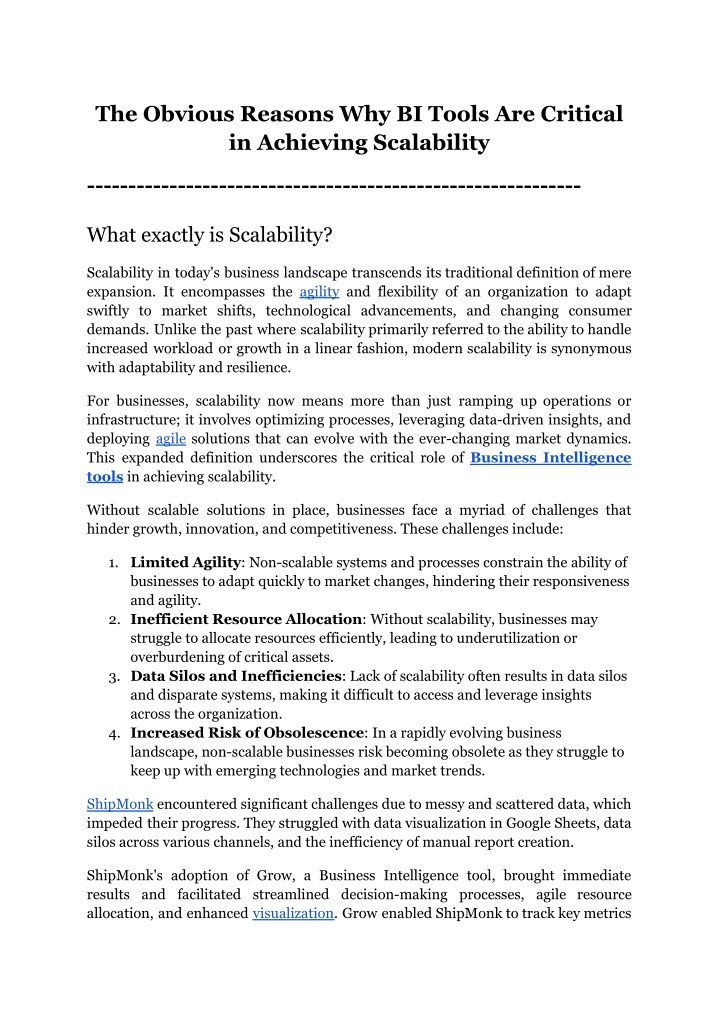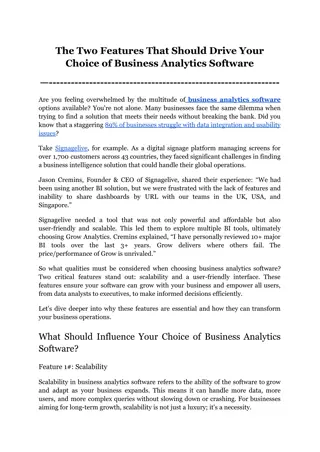
The Obvious Reasons Why BI Tools Are Critical in Achieving Scalability
nUnlock the power of scalable growth with Business Intelligence tools. Discover how Business Intelligence tools benefits in achieving scalability in today's competitive business landscape. Explore the undeniable reasons why businesses rely on BI tools to optimize processes, leverage data insights, and drive innovation.
Download Presentation

Please find below an Image/Link to download the presentation.
The content on the website is provided AS IS for your information and personal use only. It may not be sold, licensed, or shared on other websites without obtaining consent from the author. If you encounter any issues during the download, it is possible that the publisher has removed the file from their server.
You are allowed to download the files provided on this website for personal or commercial use, subject to the condition that they are used lawfully. All files are the property of their respective owners.
The content on the website is provided AS IS for your information and personal use only. It may not be sold, licensed, or shared on other websites without obtaining consent from the author.
E N D
Presentation Transcript
The Obvious Reasons Why BI Tools Are Critical in Achieving Scalability ------------------------------------------------------------ What exactly is Scalability? Scalability in today's business landscape transcends its traditional definition of mere expansion. It encompasses the agility and flexibility of an organization to adapt swiftly to market shifts, technological advancements, and changing consumer demands. Unlike the past where scalability primarily referred to the ability to handle increased workload or growth in a linear fashion, modern scalability is synonymous with adaptability and resilience. For businesses, scalability now means more than just ramping up operations or infrastructure; it involves optimizing processes, leveraging data-driven insights, and deploying agile solutions that can evolve with the ever-changing market dynamics. This expanded definition underscores the critical role of Business Intelligence tools in achieving scalability. Without scalable solutions in place, businesses face a myriad of challenges that hinder growth, innovation, and competitiveness. These challenges include: 1. Limited Agility: Non-scalable systems and processes constrain the ability of businesses to adapt quickly to market changes, hindering their responsiveness and agility. 2. Inefficient Resource Allocation: Without scalability, businesses may struggle to allocate resources efficiently, leading to underutilization or overburdening of critical assets. 3. Data Silos and Inefficiencies: Lack of scalability often results in data silos and disparate systems, making it difficult to access and leverage insights across the organization. 4. Increased Risk of Obsolescence: In a rapidly evolving business landscape, non-scalable businesses risk becoming obsolete as they struggle to keep up with emerging technologies and market trends. ShipMonk encountered significant challenges due to messy and scattered data, which impeded their progress. They struggled with data visualization in Google Sheets, data silos across various channels, and the inefficiency of manual report creation. ShipMonk's adoption of Grow, a Business Intelligence tool, brought immediate results and facilitated streamlined decision-making processes, agile resource allocation, and enhanced visualization. Grow enabled ShipMonk to track key metrics
in real-time, optimize their efforts from marketing to operations, and foster a cohesive team environment. The Core Functions of BI Tools in Scalability 1. Data Integration and Aggregation Data integration and aggregation are foundational functions of Business Intelligence tools, enabling organizations to consolidate and unify disparate data sources into a single, coherent view. This process involves extracting, transforming, and loading (ETL) data from various systems, databases, and sources, regardless of format or location. By harmonizing data from different sources, the best Business Intelligence tools provide a comprehensive understanding of organizational performance, customer behavior, and market trends, essential for informed decision-making and strategic planning. Moreover, Business Intelligence tools benefits cover robust capabilities for data cleansing, normalization, and enrichment, ensuring the accuracy, consistency, and reliability of information. This ensures that stakeholders have access to high-quality data for analysis and reporting, eliminating the inefficiencies and errors associated with fragmented data silos. By facilitating seamless data integration and aggregation, BI tools lay the groundwork for scalable analytics and insights-driven decision-making, empowering organizations to unlock the full potential of their data assets. 1. Real-time Analytics and Reporting With the pace of the business environment, real-time analytics and reporting capabilities are indispensable for maintaining competitiveness. Business Intelligence tools empower organizations to access, analyze, and visualize data in real-time, enabling stakeholders to monitor performance, detect trends, and identify opportunities or threats as they emerge. Using in-memory processing, data caching, and advanced query optimization techniques, BI tools deliver instantaneous insights and reports, eliminating latency and enabling timely actions. agility, responsiveness, and The best Business Intelligence tools offer interactive dashboards, customizable reports, and self-service analytics capabilities, empowering users to explore data dynamically and derive meaningful insights without extensive technical expertise. This democratization of data access and analysis fosters a culture of data-driven decision-making across the organization, enabling faster, more informed responses to changing market conditions and customer needs. With real-time analytics and reporting, a Business Intelligence tool enhances scalability by ensuring that
decision-makers have access to timely and relevant information to drive strategic initiatives and adapt to evolving business dynamics. 1. Predictive Modeling and Forecasting Predictive modeling and forecasting are powerful capabilities offered by Business Intelligence tools, enabling organizations to anticipate future trends, behaviors, and outcomes with accuracy and confidence. Leveraging advanced statistical algorithms, machine learning techniques, and predictive analytics models, BI tools enable businesses to identify patterns, correlations, and predictive insights hidden within their data. This allows organizations to forecast demand, optimize resource allocation, mitigate risks, and capitalize on opportunities proactively. Moreover, BI tools facilitate scenario analysis, sensitivity testing, and what-if simulations, enabling stakeholders to evaluate alternative strategies and assess their potential impact on business outcomes. This empowers organizations to make data-driven decisions with a forward-looking perspective, enhancing scalability by enabling proactive planning and strategic alignment with future market trends and customer demands. With predictive modeling and forecasting capabilities, Business Intelligence tools benefits organizations to future-proof their operations, drive innovation, and stay ahead of the competition in an increasingly dynamic and uncertain business landscape. 1. Scalable Infrastructure Management Scalable infrastructure management is a critical function of Business Intelligence tools, ensuring that organizations can efficiently process, store, and analyze large volumes of data to support their growing business needs. BI tools offer scalable architectures, distributed computing frameworks, and cloud-based deployment options that enable organizations to scale their infrastructure dynamically in response to changing demands and workloads. Furthermore, a Business Intelligence tool provides robust data governance, security, and compliance features, ensuring the integrity, confidentiality, and availability of data assets in scalable environments. This includes role-based access controls, encryption, auditing, and monitoring capabilities that protect sensitive information and mitigate security risks. While offering scalable infrastructure management capabilities, BI tools empower organizations to leverage their data assets effectively, optimize performance, and drive innovation without compromising on security or compliance requirements. How BI Tools Drive Scalability in Business Operations
1. Streamlined Decision-Making Processes Business Intelligence tool streamline decision-making processes by providing stakeholders with timely, relevant, and actionable insights that enable them to make informed decisions quickly and confidently. By centralizing data, automating analytics workflows, and delivering personalized recommendations, BI tools empower decision-makers to cut through the noise, prioritize opportunities, and align their actions with strategic objectives. This enhances scalability by enabling organizations to respond swiftly to market changes, capitalize on emerging opportunities, and optimize resource allocation for maximum impact. 1. Agile Resource Allocation and Optimization BI tools facilitate agile resource allocation and optimization by providing stakeholders with visibility into resource utilization, demand patterns, and performance metrics across the organization. By leveraging advanced analytics, optimization algorithms, and scenario modeling capabilities, a Business Intelligence tool enable organizations to allocate resources efficiently, optimize costs, and mitigate risks while scaling their operations. This enhances scalability by ensuring that organizations can adapt their resource allocation strategies dynamically to meet evolving business needs and market conditions, maximizing efficiency and value creation. 1. Enhanced Customer Experience and Satisfaction 58% of manufacturing businesses are already using cloud-based BI to get more customers. Business Intelligence tools enhance customer experience and satisfaction by enabling organizations to gain deeper insights into customer behaviors, preferences, and feedback. By analyzing customer interactions, sentiment analysis, and predictive modeling, BI tools enable organizations to personalize products, services, and experiences to meet the unique needs and preferences of their customers. This enhances scalability by driving customer loyalty, retention, and advocacy, enabling organizations to grow their customer base and market share sustainably. 1. Facilitating Innovation and Market Adaptation BI tools facilitate innovation and market adaptation by providing organizations with the insights, intelligence, and agility needed to identify emerging trends, market opportunities, and competitive threats. By analyzing market data, competitor intelligence, and consumer trends, BI tools enable organizations to anticipate shifts in the business landscape and pivot their strategies accordingly. This enhances scalability by enabling organizations to innovate proactively, enter new markets, and diversify their product or service offerings to capture new revenue streams and drive growth.
Conclusion It's abundantly clear that Business Intelligence tools are indispensable assets for organizations striving to achieve scalability environment. From data integration and real-time analytics to predictive modeling and scalable infrastructure management, BI tools offer a comprehensive suite of functionalities that empower businesses to adapt, innovate, and grow with confidence. in today's dynamic business By harnessing the power of BI tools, organizations can streamline decision-making processes, optimize resource allocation, enhance customer experience, and drive innovation all essential components of scalable growth. To experience the transformative Business Intelligence tools benefits firsthand, we invite you to start your journey with Grow today. Sign up for a 14-day free trial and discover how Grow can help your organization unlock new levels of scalability, efficiency, and success. Visit Capterra Grow.com to learn more and take the first step towards realizing your growth potential with the best Business Intelligence tools. Don't just survive thrive with Grow and unleash the power of data-driven scalability in your organization. And while you're at it, check out our blog "Grow x Unlimited: Users, Dashboards, Datasets, Metrics"






















